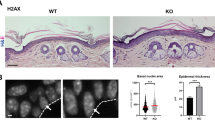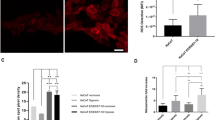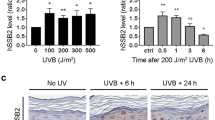Abstract
We previously reported that `high risk' human papillomaviruses (HPV) induce genetic instability in human oral keratinocytes. To understand the mechanisms of HPV-induced genetic instability, we determined the nucleotide excision repair (NER) capacity of normal (NHOK) and human papillomavirus type-16 immortalized oral keratinocytes (HOK-16B) by strand-specific removal of UV-induced cyclobutane pyrimidine dimers (CPDs) from a 16 Kb fragment of the p53 gene. In NHOK the NER activity was initiated in both DNA strands immediately, although the process in the non-transcribed strand was notably slower than that of the transcribed strand. In HOK-16B cells the initiation of CPDs removal was delayed for at least 8 h in both DNA strands, and the process was significantly slower than that in NHOK. UV-irradiation enhanced the p53 protein level more than 30-fold in NHOK, but it did not significantly alter the protein level in the HOK-16B cells. UV-irradiation also increased the p21WAF1/CIP1 protein level only in NHOK. These data indicate that `high risk' HPV induces genetic instability by impairing NER capacity of cells. Impaired NER activity of HOK-16B cells may be implicated with their inability to enhance active p53 when challenged by genotoxic stress.
This is a preview of subscription content, access via your institution
Access options
Subscribe to this journal
Receive 50 print issues and online access
$259.00 per year
only $5.18 per issue
Buy this article
- Purchase on Springer Link
- Instant access to full article PDF
Prices may be subject to local taxes which are calculated during checkout





Similar content being viewed by others
References
Aboussekhra A and Wood RD. . 1994 Curr. Opin. Genet. Dev. 4: 212–220.
Androphy EJ, Hubbert NL, Schiller JT and Lowry DR. . 1987 EMBO J. 6: 989–992.
Bakalkin G, Yakovleva T, Selivanova G, Magnusson KP, Szekely L, Kiseleva E, Klein G, Terenius L and Wiman KG. . 1994 Proc. Natl. Acad. Sci. USA 91: 413–417.
Band V, Dalal S, Delmolino L and Androphy EJ. . 1993 EMBO J. 12: 1847–1852.
Bohr VA, Smith CA, Okumoto DS and Hanawalt PC. . 1985 Cell 40: 359–369.
Coverley D, Kenny MK, Lane DP and Wood RD. . 1992 Nucleic. Acids Res. 20: 3873–3880.
Dutta A, Ruppert JM, Aster JC and Winchester E. . 1993 Nature 365: 79–82.
el-Deiry WS. . 1998 Curr. Topics Microbiol. Immunol. 227: 121–137.
el-Deiry WS, Harper JW, O'Connor PM, Velculescu VE, Canman CE, Jackman J, Pietenpol JA, Burrell M, Hill DE and Wang Y et al. 1994 Cancer Res. 54: 1169–1174.
Ford JM and Hanawalt PC. . 1995 Proc. Natl. Acad. Sci. USA 92: 8876–8880.
Ford JM, Baron EL and Hanawalt PC. . 1998 Cancer Res. 58: 599–603.
Foster SA, Demers GW, Etscheid BG and Galloway DA. . 1994 J. Virol. 68: 5698–5705.
Fritsche M, Haessler C and Brandner G. . 1993 Oncogene 8: 307–318.
Hubbert NL, Sedman SA and Schiller JT. . 1992 J. Virol. 66: 6237–6241.
Ishizaki K, Ejima Y, Matsunaga T, Hara R, Sakamoto A, Ikenaga M, Ikawa Y and Aizawa S. . 1994 Int. J. Cancer 58: 254–257.
Li S-L, Kim M, Cherrick HM and Park N-H. . 1992 Eur. J. Cancer 28B: 129–134.
Liu X, Han S, Baluda MA and Park NH. . 1997 Oncogene 14: 2347–2353.
Park NH, Min BM, Li SL, Huang MZ, Cherick HM and Doniger J. . 1991 Carcinogenesis 12: 1627–1631.
Rey O, Baluda MA and Park NH. . 1999 Oncogene 18: 827–831.
Rey O and Nayak DP. . 1992 J. Virol. 66: 5815–5824.
Sancar A. . 1994 Science 266: 1954–1956.
Sancar A and Tang MS. . 1993 Photochem. Photobiol. 57: 905–921.
Scheffner M, Werness BA, Huibregtse JM, Levine AJ and Howley PM. . 1990 Cell 63: 1129–1136.
Shin KH, Tannyhill RJ, Liu X and Park NH. . 1996 Oncogene 12: 1089–1096.
Tommasino M, Adamczewski JP, Carlotti F, Barth CF, Manetti R, Contorni M, Cavalieri F, Hunt T and Crawford L. . 1993 Oncogene 8: 195–202.
van der Horst GT, van Steeg H, Berg RJ, van Gool AJ, de Wit J, Weeda G, Morreau H, Beems RB, van Kreijl CF, de Gruijl FR, Bootsma D and Hoeijmakers JH. . 1997 Cell 89: 425–435.
Wang XW, Forrester K, Yeh H, Feitelson MA, Gu JR and Harris CC. . 1994 Proc. Natl. Acad. Sci. USA 91: 2230–2234.
Wang XW, Yeh H, Schaeffer L, Roy R, Moncollin V, Egly JM, Wang Z, Freidberg EC, Evans MK and Taffe BG et al. 1995 Nat. Genet. 10: 188–195.
White AE, Livanos EM and Tlsty TD. . 1994 Genes Dev. 8: 666–677.
Acknowledgements
We would like to thank Marcel A Baluda and Bradley Ackerson for critical reading of this manuscript. This work was, in part, supported by grants DE11229 and DE10598 from the National Institute of Dental and Craniofacial Research, National Institutes of Health, Bethesda, MD, USA.
Author information
Authors and Affiliations
Rights and permissions
About this article
Cite this article
Rey, O., Lee, S. & Park, NH. Impaired nucleotide excision repair in UV-irradiated human oral keratinocytes immortalized with type 16 human papillomavirus genome. Oncogene 18, 6997–7001 (1999). https://doi.org/10.1038/sj.onc.1203180
Received:
Revised:
Accepted:
Published:
Issue Date:
DOI: https://doi.org/10.1038/sj.onc.1203180
Keywords
This article is cited by
-
HPV 16 E7 alters translesion synthesis signaling
Virology Journal (2022)
-
Proinflammatory cytokine TNFα promotes HPV-associated oral carcinogenesis by increasing cancer stemness
International Journal of Oral Science (2020)
-
Three Prime Repair Exonuclease 1 (TREX1) expression correlates with cervical cancer cells growth in vitro and disease progression in vivo
Scientific Reports (2019)
-
Mouse mismatch repair gene Msh2 is not essential for transcription-coupled repair of UV-induced cyclobutane pyrimidine dimers
Oncogene (2001)



